
|
 |
 |
ilp archive : southport 1947
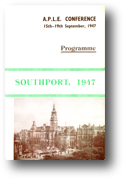
|
Programme
Annual Conference at Southport
September 15th-19th, 1947
"The APLE has accepted the cordial invitation of the Mayor and Corporation of Southport to hold the next Conference
in their town. An important sessional meeting, with the subject of Safety First as it pertains to street lighting, will be held
in the Floral Hall." - Public Lighting #44, January-March 1947.
The delegates will have an opportunity of witnessing a demonstration in a series of selected roads. Both electric and gas,
and Group A and Group B roads, are at the disposal of the manufacturers for this demonstration.
The Conference will extend from the afternoon of Monday, September 15th until Friday 19th. On the opening day, the Annual Meeting will
be held, and the incoming President, Mr. Thomas Wilkie, will be installed. To conclude the Conference on Friday 19th, a coach trip is
arranged for a visit to the Liverpool docks and an opportunity to see the lighting of the Mersey Tunnel. A special session
is being arranged for Wednesday 17th, when the subject of Safety First, with particular reference to road lighting
is to be discsused from differing angles. The meeting will be of a special character and the Council is inviting various
Associations to contribute their views on the subject.
The Council is offering a prize of 25 guineas for the best paper on "Safety First on the Highway". To include the
essentials for road safety, with special reference to road lighting. The competition is open to all. The author will be
invited to present it at the monring session of September 17th.
Arrangements are well advanced for the next conference which is to be held
at Southport in September (15th-19th). Street lighting apparatus and equipment will be
displayed on several of the highways adjacent to the Conference Hall and the lamps will
be lighted each evening. There will be a display of modern street lamp columns, which will
be erected together in the gardens on the seafront. This exhibition of columns is most
appropriate, especially in view of the renewed interest now been taken in street furniture by
the Royal Fine Art Commission. The Secretary of the Commission will be delivering an
address on the subject at the conference. - Public Lighting #45, April-June 1947.
On the last day of Conference a motor coach trip is being arranged, which will include a
visit to the now world-famous Mersey Tunnel with its modern and efficient lighting. - Public Lighting #45, April-June 1947.
Outside Street Lighting Demonstration
A group of roads, situated conveniently to the Conference Hall (Cambridge Hall) have been
relighted with modern equipment - both by gas and electricity - and these will bb alight
each evening for inspection. On Wednesday evening (17th), groups of visitors will eb
conducted to inspect these installations and manufacturers representatives will be available to
give further information. - Public Lighting #45, April-June 1947.
| William Edgar & Son |
Eclipse 5 No 2. |
B |
Bold Street |
15 ft. |
Staggered |
Nine of the smaller Eclipse units were installed. They were fitted with Holophane dishes, Horstmann
Clock Controllers and Comet Igniters and included five No. 2 mantles. Mounted at 15ft. on swan necks. (The lamps were not
quite at the full mounting height for Class 'B' as the street in question was subject to high winds and the swan neck had to be made
as short and sturdy as possible). |
| Elm Works |
Majestic 12 No 2. |
A |
Manchester Road
Pt. Hoghton Road
Marlborough Road |
6-20 ft. |
One side (outside of bend) |
Six 12-light low pressure gas lanterns of the bowl type suitable for central suspension or for kerb mounting; adjustable mirror glass reflectors screen the light source from approaching motorists |
| Elm Works |
Elmax 4 No. 2 |
B |
Leicester Street
Irving Street
Gordon Street |
15 ft. |
Staggered |
Seven Elmax four light No. 2 mantles have been installed.
Have extended frogs to increase the mounting height. |
| Foster & Pullen, Ltd. |
Alpha 12 No. 2 |
A |
Mornington Road
Hoghton Street
Vulcan Street |
20 ft. |
One Side |
Fitted with twelve No. 2 mantles in strip formation with an improved reflector system |
| Foster & Pullen, Ltd. |
Sideway 4 No. 2 |
B |
Portland Street
Pt. Lord Street
Talbot Street |
15 ft. |
Staggered |
| C. H. Kempton & Co. Ltd. |
Stellaris 4 No. 2 |
B |
Avondale Road
Seabank Road
Saunder Street |
15 ft. |
Staggered |
Designed for carriageways less than 30ft. in width. |
| Lighting Trades & Welsbach Ltd. |
Renown 3 No. 2 with Burman prisms |
B |
Portland Street
Talbot Street
L.M.S. Rly. |
15 ft. |
Staggered |
This is a new method of light distribution, using a prism of heat-resisting glass. |
| W. Parkinson & Co. |
Maxilla 6 No. 2 and Maxillette |
B |
Portland Street
Duke Street
Lord Street
Talbot Street
St. Paul's Square |
15 ft. |
Staggered |
Of compaaratively small dimensions with a reflector scheme designed to give increased candle power
at angles between 70° and 80° from the downward vertical. Have a mounting height of 15ft. and column spacings of
130ft. (staggered) |
| William Sugg & Co., Ltd. |
Southport 6-G. Supervia strip mantles |
A |
Lord Street (West)
Duke Street
Aughton Road |
21 ft. 6 in. |
Curved (Opposite) |
Installed in the double-unit form, providing suitable lighting for main traffic routes or shopping centres. The units are designed for direct mounting to traffic arms.
Is part of a contract placed with the Southport Gas Committee. Fitted with low-pressure
Supervia strip mantles (from the South Metropolitan Gas Company) and Horstmann
control equipment. |
| William Sugg & Co., Ltd. |
8000 4 No. 2 |
B |
Westcliffe Road |
14-15 ft. |
Staggered |
A variety of mountings to meet varying requirements: 'H' type (for steel pole mounting), 'G' type (concrete) and
'D' type (swan neck) |
| Willey & Co. Ltd. |
Cranford 4 No. 2 |
B |
Seabank Road |
15 ft. |
Staggered |
A lamp of modern appearance available either with swan-neck or post mounting or as a wall
bracket unit. |
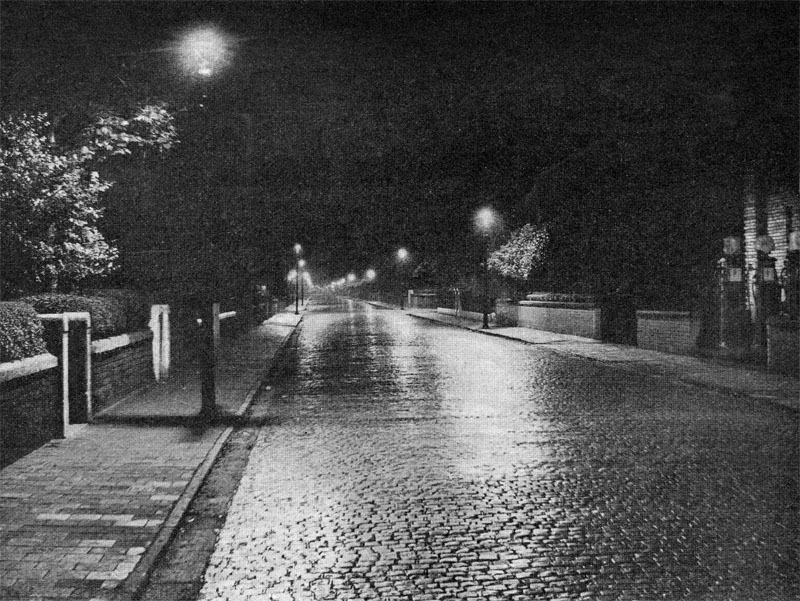
Installation of Foster & Pullen Sideway lanterns along Portland Street.

Installation of Willey Cranford lanterns along Seabank Road.
| REVO Electric Co. Ltd. |
Sol-etern Lanterns No. C. 12492 |
2 80W 5-ft. Fluorescent tubular type |
A |
Kingsway & Coronation Walk |
25 ft. |
120/130ft. respectively |
|
In conjunction with Philips Electrical Ltd. |
| British Thomson-Houston Co. Ltd. |
Mazdalux 3-lamp Fluorescent Cat. No. SL 753 on specially designed Concrete Utililites' columns. |
Mazda 80-watt warm-white 5-ft. fluorescent |
A |
Neville Street |
25 ft. |
120 ft. |
Single and Double Staggered |
Six units mounted on specially designed Concrete Utilities columns. The street, a busy shopping throughfare,
represents many of the type of location where fluorescent lighting can be used with fine results. Part of the street being narrow, four lanterns
were sited at single, staggered 120 ft. spacing, the other two placed directly opposite each other. |
| Falk Stadelmann & Co., Ltd. |
Hilux Lantern |
Vertical 400-watt MA/V Mercury discharge type. |
A |
Hoghton Street |
25 ft. |
120 ft. |
Singe sided. |
Eight lanterns installed on existing ex-tramway standards on extension brackets
having a projection of approximately 10 ft. over the roadway. Single-sided overhung. Total of 10,000 lumens per
hundred foot of roadway which is better than the MOT Report Group A specification. |
| Holophane Ltd. |
Dilux Lantern |
Magnetically controlled horizontal burning 400-watt MA/H Mercury Discharge type |
A |
London Street |
25 ft. |
130 ft. |
Staggered. |
Light output of the lantern was 7,350 lumens per 100 ft. linear of road. |
| General Electric Co., Ltd. |
Four Eighty Z 8481 Lantern |
Each lantern with 4 80-watt fluorescent tubular type. |
A |
Hoghton Street |
24 ft. approx |
112 ft. average |
Staggered. |
Seven units installed. The lanterns are clamped on two tubes which project from the special columns designed for them
by Concrete Utilities in which the lantern head butts agains the colum. Gives approximately 5000 lumens per 100 ft.
of roadway Switching is by Horstmann time switches provides for two lamps in each lantern to be cut out
as required.. |
| Siemens Electric Lamps & Supplies, Ltd. |
Euston-Sieray |
250-watt Sieray MA/V burning horizontally with magnetic arc deflector. |
A |
East Bank Street |
25 ft. approx |
105 ft. average |
Side mounted 4ft. 6in. overhang. |
Eight units installed. It was desirable to employ the minimum of material and labour on this
demonstration, bearing in mind the present difficult national situation, and they decided to make use of existing poles
which were not ideally suited. Of the eight poles, six were on one side of the road. The light output per 100 ft. linear
of roadway was approximately 4500 lumens that is towards the lower end of the Group A range.
The mounting height was
25' to light source and the spacing averaged 105'. Sieray MA/V 250W lamps were burnt horizontally with Sieray magnetic
arc deflectors mounted above them to centalise the arc of the discharge tube.
The brackets, which were specially designed for this particular installation, were fixed to the pole by means of clamps and the
Sieray control gear was housed in sheet steel boxes which again were clamped to the existing columns. Special adaptors were made up to
fit into the G.E.S. holders of the existing fittings so that the dismantling of the existing lantern was unnecessary.
|
| Engineering & Lighting Equipment Co., Ltd. |
Golden Ray Lantern |
140-watt Philora Sodium Discharge type. |
A |
East Bank Street |
25 ft. approx |
|
Unilateral. |
Eight fittings were spaced 35 yards apart on average of necessity unilaterally. Despite this, there
is a broad horizontal distribution and adequate illumination over the entire road. In conjunction with Philips Electrical Ltd. |
| Wardle Engineering Co, Ltd. |
Solar Lantern |
140-watt Sodium type. |
A |
Scarisbrick New Road |
21 ft. 6 in. approx |
120 ft. approx. |
Centre-mounting on traction pole arms. |
In conjunction with Philips Electrical Ltd. Eight units installed. |
| Brighton Lighting & Electric Engineering Co., Ltd. |
"W" Lantern |
140-watt Philora Sodium type, horizontal burning. |
A |
Scarisbrick New Road |
21 ft. approx |
120 ft. approx. |
Centre-mounting on traction pole arms. |
In conjunction with Philips Electrical Ltd. |
| Metropolitan-Vickers Electrical Co., Ltd. |
Trafford Class A Lanterns |
400-watt Mercury type horizontal disposed. |
A |
Scarisbrick New Road |
20 ft. approx |
120 ft. approx. |
Centre-mounting on traction pole arms. |
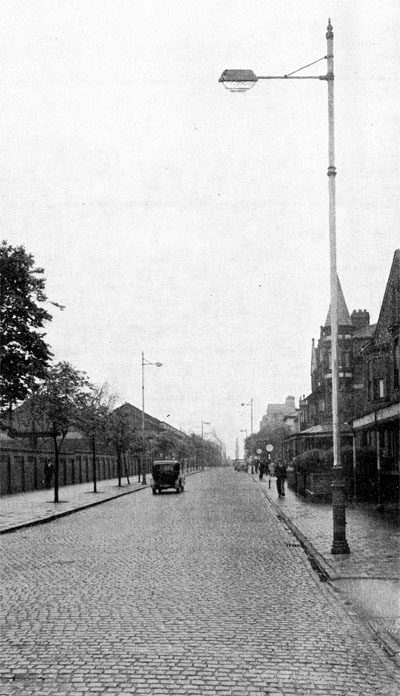
Installation of Holophane Dilux lanterns along Scarisbrick New Road.
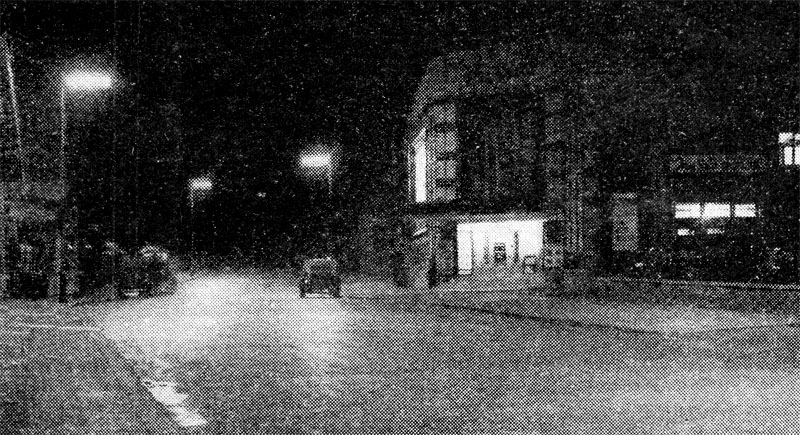
Installation of REVO Sol-Etern lanterns along Coronation Walk.
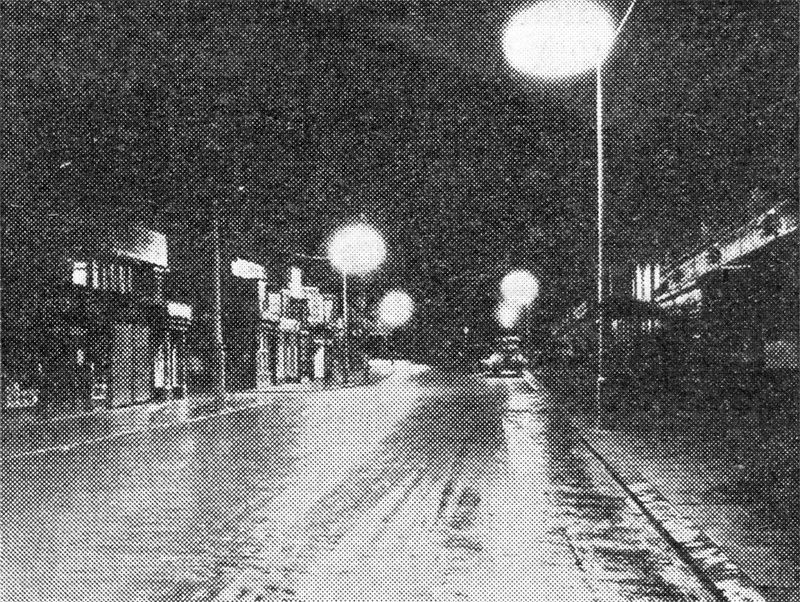
Installation of BTH Fluorescent lanterns along Neville Street.
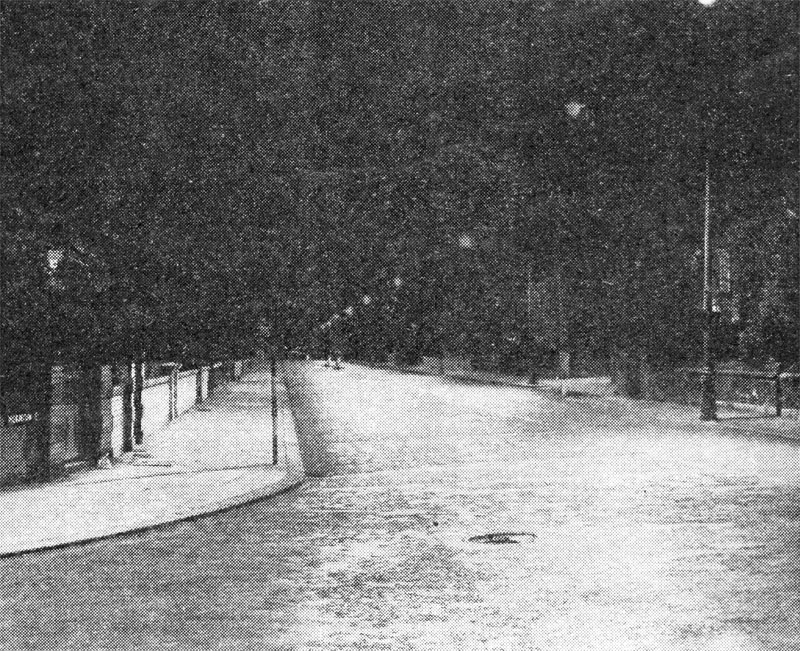
Installation of Falks Hilux lanterns along Hoghton Street.
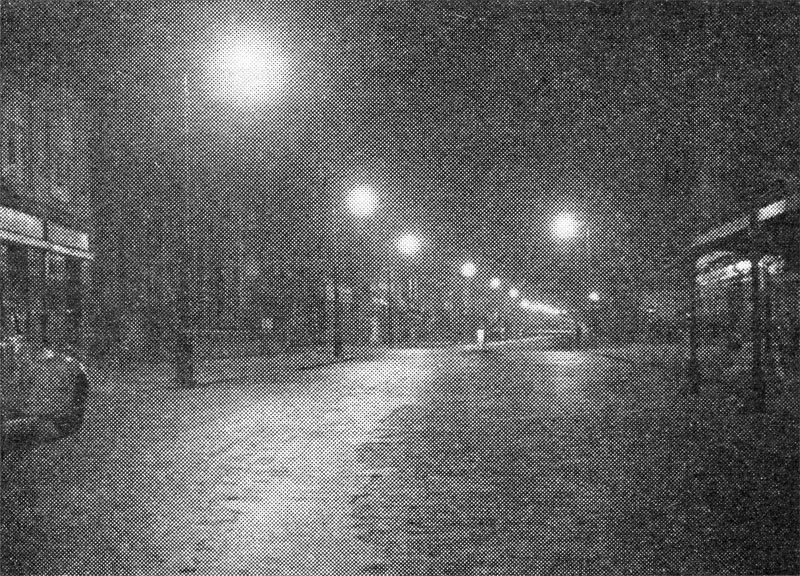
Installation of Siemens Euston-Sieray lanterns along East Bank Street.
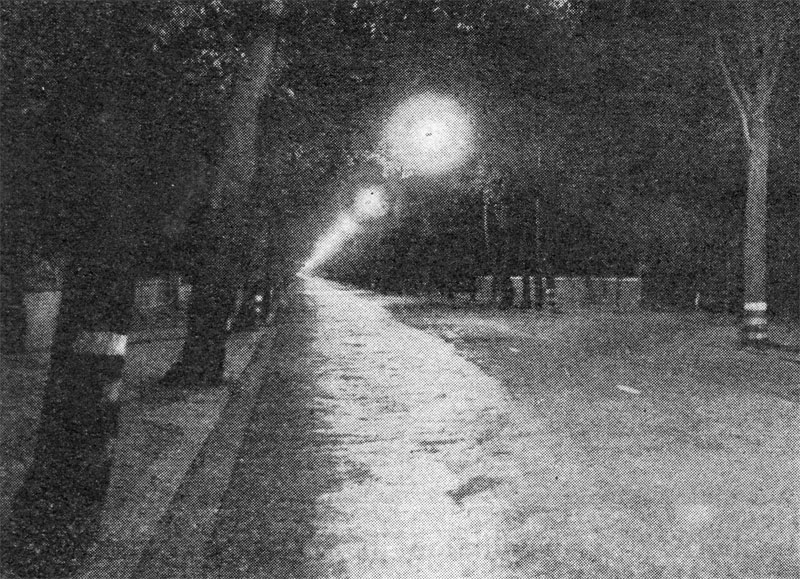
Installation of Metropolitan Vickers Trafford lanterns along Scarisbrick Road.
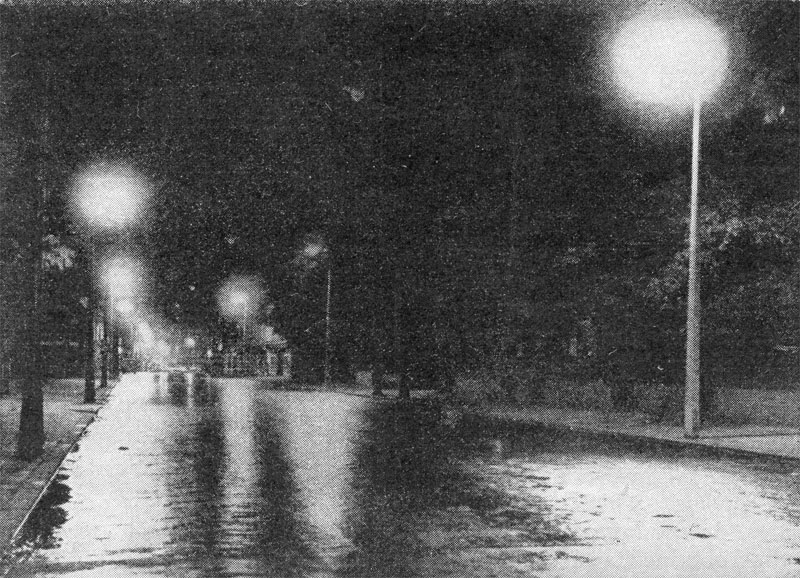
Installation of GEC Four-Eighty lanterns along Hoghton Street.
Lamp Columns
In the future, more attention is to be given to street furniture and the lamp column itself,
apart from the lamp, will have to conform to definite lines. In order to provide visitors with
a representative display of modern steel and concrete columns, arrangements have been made for
a special display in the gardens between the New Bridge and the Pier. These will be erected in a row
at approximately 12 ft. intervals, each manufacturer exhibiting his group of columns together. - Public Lighting #45, April-June 1947.
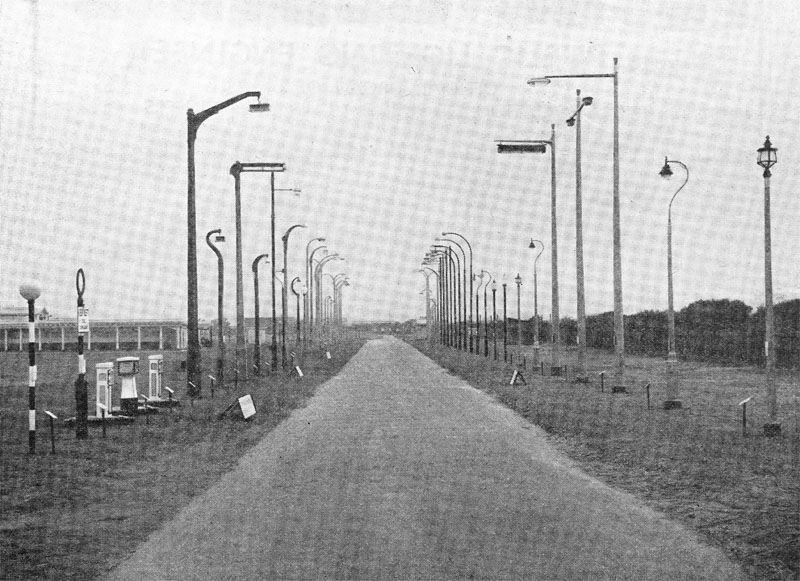
| Gowshall |
Small group of illuminated guard posts. |
| REVO Electric Company |
Columns. |
| Broad and Company |
Concrete columns. |
| Johnston Brothers (Contractors) |
Concrete columns. |
| Spun Concrete |
Concrete columns. |
| Stewarts And Lloyds |
Have erected on the sea-front twelve Tubular Steel Poles:
(1) Eight poles of two types for Group A roads: Bracket-Arm and Shepherd's Crook. Four
have Pendant Lanterns and four have Side-Entry Lanterns
(2) Four poles of two types for Group B roads: Swan-Neck and Pillar. Poles
are shown of the Plain Circular and Fluted form. The poles have no added ornamentation.
Many engineers condiser ornamentation not
only unnecessary on aesthetic grounds but undesirable from a utility and maintenence point of view. |
| Poles Limited |
Have erected seven columns:
(1) A hexagonal 25ft. column with double bracket arms supporting two Metropolitan-Vickers Electrical Company's Trafford Lanterns
(2) A hexagonal 25ft. column with single bracket arms carrying British Thompson-Houston Company's Mazdalux fluorescent fitting
(3) A circular 25ft. column with single bracket arms carrying General Electric Company's Dioptrion Lantern
(4) A hexagonal 15ft. column fitted with swan-neck bracket and an expanded base incorporating an inspection door and carrying a British Thompson-Houston Company's Dilen Junior
(5) A circular 15ft. column fitted with swan-neck bracket and an expanded base incorporating an inspection door and carrying a British Thompson-Houston Company's Dilen Junior
(6) A hexagonal 15ft. column adapted for fitting a lantern vertically at the top and carrying a REVO Electric Company's C.10239 lantern
(7) A circular 15ft. column adapted for fitting a lantern vertically at the top and carrying a REVO Electric Company's C.10239 lantern
|
| Stanton Ironworks Company Limited |
Four concrete columns are displayed: 1B, 6B with BLEECO Streamline lantern, 7A and 7B.
|
| Concrete Utilities Limited |
Are showing a very full range on the demonstration site. The columns on exhibition are in various finishes, the
standard being rubbed cemment. They erected 10 Group "A" columns with Arc II and Avenue type
brackets, ranging from 2 ft. 6 ins. to 6 ft. outreach. They also demonstrated two columns with 2 ft. 6 ins. double arm
brackets and four types of Group "B" columns. The firm can offer delivery from four works at Ware, Cardiff, Ipswich and
Liverpool. With the exception of one column, all exhibited showed the rubbed cement finish. Although a ground finish can
be supplied, atmospheric corrosion will remove free cement and give a natural pitted appearance - this is not
detrimental to the column and enables it to weather to tone with the surrounding buildings. Also exhibited were columns
designed to take the latest designs of fluorescent lanterns by the General Electric Co. Ltd. and British
Thomson-Houston Co., Ltd.. William Sugg & Co. Ltd. have also been developing brackets with the firm and the
Sugg C.U. Avenue 2D Column with special bracket arm was shown.
|
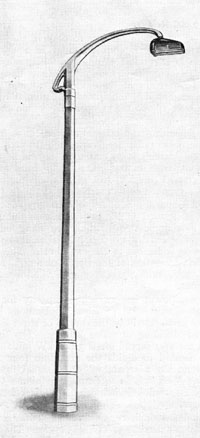
Stanton 6B column with BLEECO Streamline sodium lantern as
displayed at the Princes Park, Southport, during the APLE Conference. - Public Lighting #47, 1947
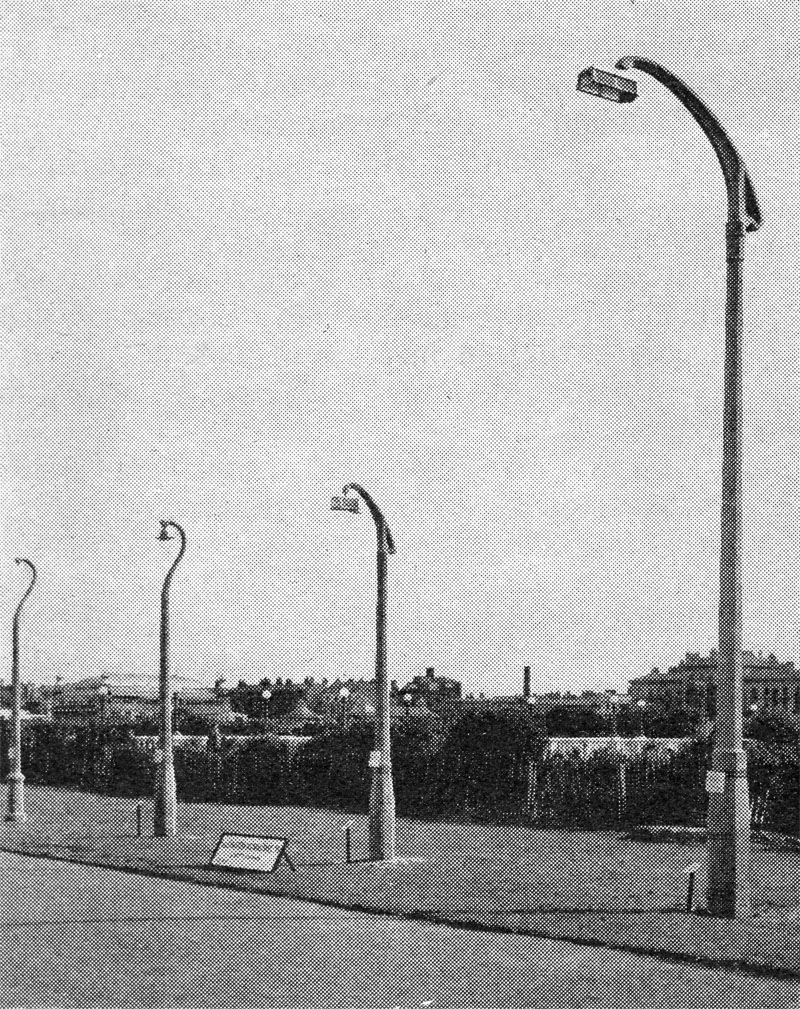
Stanton display at Princes Park, Southport, during the APLE Conference. From left to right: Type 1B,
Type 7A (with Metropolitan Vickers lantern), Type 7B
(with GEC Z9420 sodium lantern - as installed in Salisbury) and Type 6B
(with BLEECO Streamline sodium lantern).- Public Lighting #47, 1947
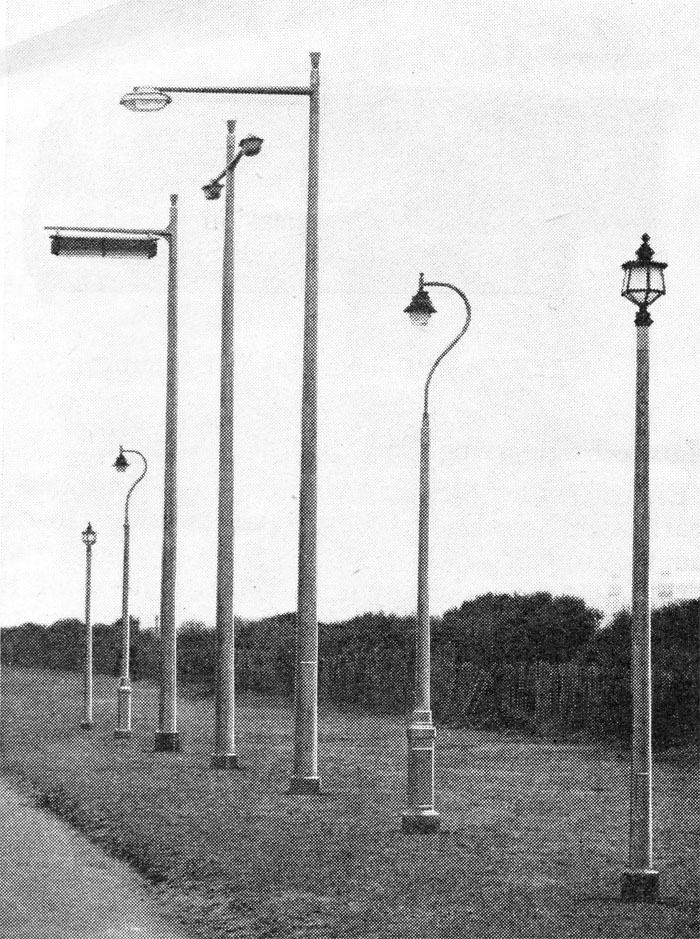
Poles Limited display at Princes Park, Southport, during the 1947 APLE Conference. From left to right:
13 ft. hexagonal column adapted for fitting a lantern vertically on the top fitted with a REVO C 10239,
15 ft. hexagonal column fitted with swan neck bracket and having an expanded base incorporating an inspection door
with a BTH Dilen Junior,
25 ft. hexagonal column with single bracket arm carrying a BTH Mazdalux Fluorescent lantern,
25 ft. hexagonal column with double bracket arms supporting two Metropolitan Vickers Trafford lanterns,
25 ft. circular column with single bracket arm and a GEC Dioptrion lantern,
15 ft. circular column fitted with swan neck bracket and having an expanded base incorporating an inspection door
with a BTH Dilen Junior and a
13 ft. circular column adapted for fitting a lantern vertically on the top fitted with a REVO C 10239, 13 ft. hexagonal column adapted for fitting a lantern vertically on the top fitted with a REVO C 10239.
- Public Lighting #47, 1947
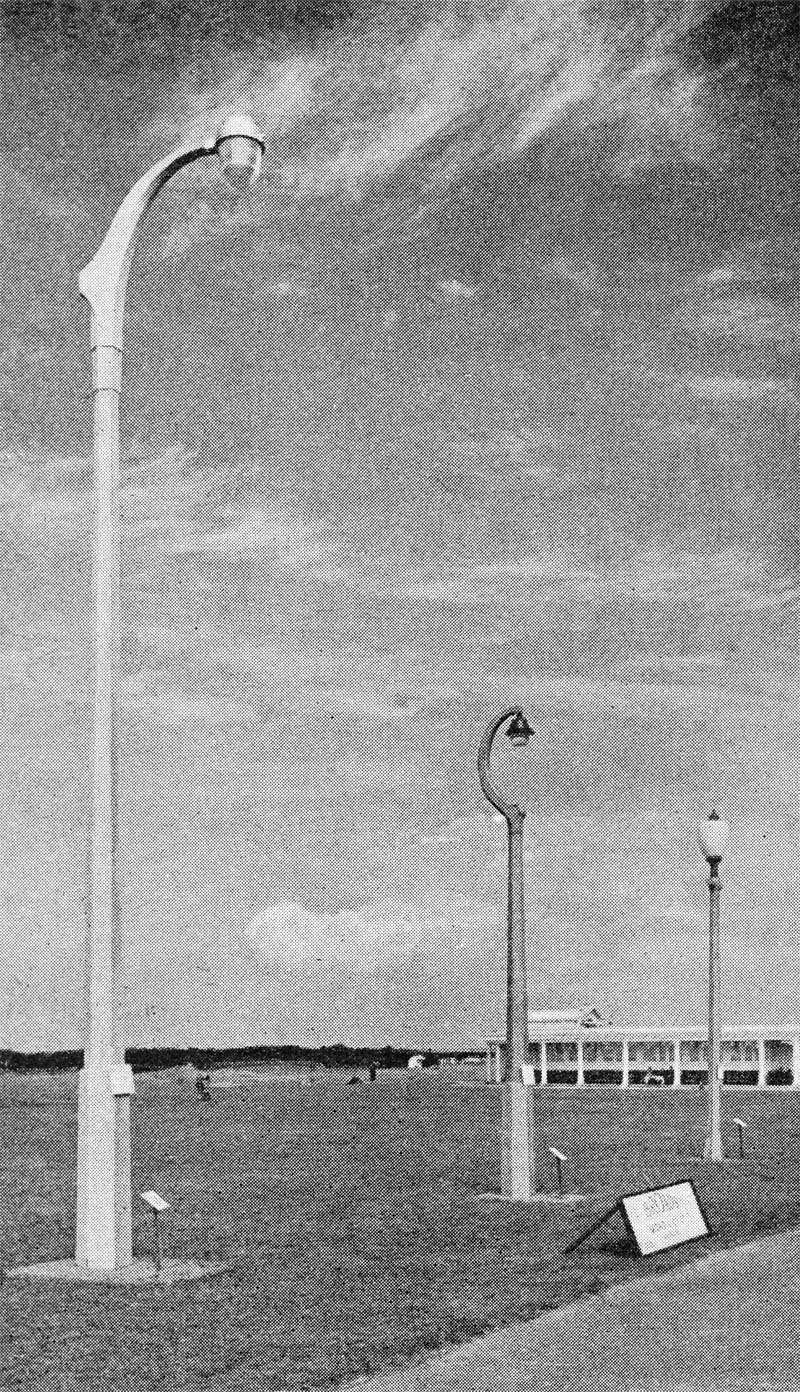
Broad and Company display at Princes Park, Southport, during the APLE Conference. - Public Lighting #47, 1947
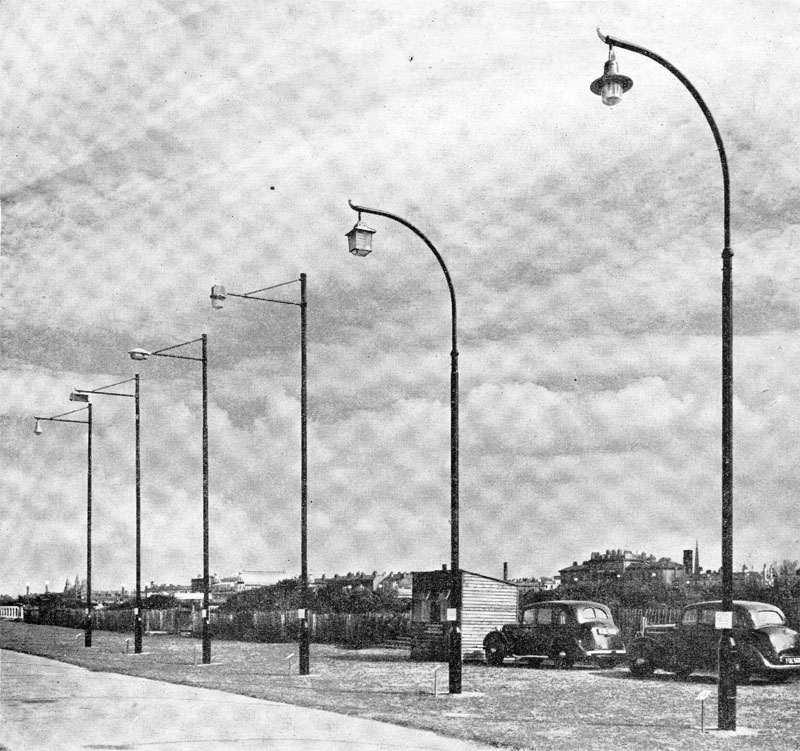
Stewarts And Lloyds display at Princes Park, Southport, during the APLE Conference. - Advert, 1947
Planned exhibitors and stand numbers were:
(1) William Edgar & Son Ltd.,
(2 & 3) Elm Works Ltd.,
(4 & 5) Foster And Pullen Ltd.,
(6) C. H. Kempton & Co. Ltd.,
(7) Lighting Trades Ltd. and the Welsbach Light Co., Ltd.,
(8) Parkinson & Cowan (Gas Meters) Ltd.,
(9 & 10) William Sugg And Co., Ltd.,
(11) Willey And Co., Ltd.,
(12) REVO Electric Co., Ltd.,
(13) The British Thomson-Houston Co. Ltd.,
(14) Falk, Stadelmann and Co. Ltd.,
(15) Holophane, Limited,
(16) The General Electric Co., Ltd.,
(17) Siemens Electric Lamps And Supplies Ltd.,
(18) Engineering And Lighting Equipment Co., Ltd.,
(19) Wardle Engineering Co. Ltd.,
(20) The Brighton Lighting And Electrical Engineering Company, Ltd. and
(21) Metropolitan Vickers Electrical Co., Ltd..
Note: No other stand numbers were given in the programme or in the adverts after stand 21.
Abstract: Descriptions of lanterns and equipment displayed by:
William Edgar & Son Ltd.,
Elm Works Ltd.,
Foster And Pullen Ltd.,
C. H. Kempton & Co. Ltd.,
Lighting Trades Ltd. and the Welsbach Light Co., Ltd.,
Parkinson & Cowan (Gas Meters) Ltd.,
William Sugg And Co., Ltd.,
Willey And Co., Ltd.,
British Gas Council,
Gas Meter Company Ltd.,
REVO Electric Co., Ltd.,
The British Thomson-Houston Co. Ltd.,
Falk, Stadelmann and Co. Ltd.,
Holophane, Limited,
The General Electric Co., Ltd,
Siemens Electric Lamps And Supplies Ltd.,
Engineering And Lighting Equipment Co., Ltd.,
Wardle Engineering Co. Ltd.,
The Brighton Lighting And Electrical Engineering Company, Ltd.,
Metropolitan Vickers Electrical Co., Ltd.,
Stewarts And Lloyds, Ltd.,
Simplex Electrical Co., Ltd.,
Measurement Ltd.,
Philips Electrical Ltd.,
Gowshall Limited,
Spun Concrete Ltd.,
Venner Time Switches Ltd.,
Poles Ltd,
The Electric Street Lighting Apparatus Co.,
British Foreign and Colonial Automatic Light Controlling Co. Ltd.,
Broad & Co. Ltd.,
British Sangamo Co. Ltd.,
Stanton Ironworks Co., Ltd.,
British Electrical Development Association,
Concrete Utilities Ltd. and
Franco Traffic Signs Limited.
Adverts:
Radiovisor Parent Ltd.,
William Edgar & Son Ltd.,
Elm Works Ltd.,
Foster And Pullen Ltd.,
C. H. Kempton & Co. Ltd.,
Lighting Trades Ltd. and the Welsbach Light Co., Ltd.,
Parkinson & Cowan (Gas Meters) Ltd.,
William Sugg And Co., Ltd.,
Willey And Co., Ltd.,
British Gas Council,
Gas Meter Company Ltd.,
REVO Electric Co., Ltd.,
The British Thomson-Houston Co. Ltd.,
Falk, Stadelmann and Co. Ltd.,
Holophane, Ltd.,
The General Electric Co., Ltd,
Siemens Electric Lamps And Supplies Ltd.,
Engineering And Lighting Equipment Co., Ltd.,
Wardle Engineering Co. Ltd.,
The Brighton Lighting And Electrical Engineering Company, Ltd.,
Metropolitan Vickers Electrical Co., Ltd.,
Stewarts And Lloyds, Ltd.,
The Horstmann Gear Co., Ltd.,
The Horstmann Gear Co., Ltd.,
Simplex Electrical Co., Ltd.,
Measurement Ltd.,
Philips Electrical Ltd.,
Record Electrical Co. Ltd.,
Gowshalls Limited,
Spun Concrete Ltd.,
Venner Time Switches Ltd.,
Poles Ltd,
Poles Ltd,
Poles Ltd,
The Electric Street Lighting Apparatus Co.,
Automatic Telephone And Electric Company Limited,
Automatic Light Controlling Co. Ltd.,
Broad & Co. Ltd.,
Crompton Parkinson Ltd.,
British Sangamo Co. Ltd.,
Stanton Ironworks Co., Ltd.,
British Electrical Development Association,
Concrete Utilities Ltd.,
Franco Traffic Signs Limited,
Johnston Brothers Ltd.,
Ekco-Ensign Ltd.,
Edison Swan Electric Co. Ltd.,
J. E. Wildbore,
Public Lighting,
Hobbs, Offen and Co. Ltd.,
Londex Ltd. and
The General Electric Co., Ltd.
Provisional papers (as planned in Public Lighting #45):
- Presidential Address by Mr. Thomas Wilkie, F.I.E.S.
- Street Lighting in Relation to Road Safety, Traffic Problems and Crime Protection by Mr. A. E. Marchant, M.I.E.E. (Barking) and Mr. Robert Bell, A.M.I.E.E. (Erith)
- Maintenance of Street Lighting by Mr. J. Woodhouse (Sheffield)
- Photometry in Relation to Public Lighting by Dr. S. English, F.I.C., F.Inst.P.
- Lighting of Class 'B' side and Residential Roads by Mr. R. W. Steel (Cheltenham)
- The Royal Fine Art Commission and Lamp Columns by Mr. A. B. Knapp-Fisher, F.R.I.B.A., F.S.A., Hon.A.R.C.A
|

|
Presidential Address
Thomas Wilkie, F.I.E.S
(Lighting Department, Leicester)
Tuesday, September 16th, 1947
|

|
Street Lighting in relation to Road Safety, Traffic Problems and Crime Prevention
A. E. Marchant, M.Sc.Tech., M.I.E.E., A.M.I.Mech.E and
Robert Bell, Assoc.M.C.T., M.I.E.E., A.M.I.Mech.E
Keywords: Lighting: Anti-Social Behaviour, Lighting: ARP, Lighting: Energy,
Lighting: History, Lighting: Health, Lighting: Levels, Lighting: Safety,
Lighting: Statistics, Lighting: Users, Statistics: Accident Data,
Statistics: Road Data
Tuesday, September 16th, 1947
A reproduction of the paper was published in: Public Lighting, Vol. 12, No. 46. July-September 1947. This
includes the discussion.
Abstract: The principle aim of street lighting is safety. The paper outlines the effects of the war,
in particularly the black-out, star-lighting, moon-lighting and the current half-lighting (running
street lighting at 50% of pre-war levels). Accident rates for both pre and post-war periods are examined.
The justification for street lighting is made on the groups of its prevention of more costly accidents.
The concept of road safety is examined and ideas are put forward which may alleviate the situation.
The connection between street lighting and crime is also examined.
INTRODUCTION
First-class street lighting is not just a pleasant amenity but a necessity. Our demands, at this juncture and reluctantly,
must be looked upon as a long-term policy due to the existing state of fuel supplies. It is now intimated that reinstatement
of up to 50% of our street lighting this winter will be allowed. Except in very few installations one cannot reduce a
street lighting load of 50% by the simple expedient of cutting off every other lantern without completely upsetting the light
distribution of the scheme. How such economies can be effected whilst still preserving reasonable visibility is a question
for the public lighting engineer. Each road and street must obviously be treated on its merits if the best results
are to be achieved and, in our view, Group B roads should receive at least the same consideration as those in Group A.
The war has left us a legacy of hooliganism and reckless disregard for the lives and property of others. To some extent
this is understandable, since one cannot hope to train large numbers of the male population to be silent killers and
raiders withotu in that number finding some with criminal tendencies. The stringencies and shortages of so much that used
to make life worth while, and the apparent ease with which illegally aquired goods can be disposed of, offer attractive possibilites
to such as these.
Light is the enemy of all vermin, whether two or four legged; given plenty of light in our streets the forces of law and
order will have a reasonable chance of coping with the situation; without it their task is made much more difficult. Crime
and properly lighted streets do not go together, and good street lighting increases the effective strength of the police
force.
Police forces are, in the main, undermanned, and there is difficulty in obtaining sufficient recruits to replace normal
wastage. It is hoped that this is a transitory phase. Whatever the cause of our reduced police strengh, the fact remains that
the police need all the help they can get, and it is peculiarly unfortunate that we are unable to help in the best way
possible by providing proper lighting in our streets.
BRIEF REVIEW OF STREET LIGHTING DURING PAST EIGHT YEARS
Eight years ago, in September 1939, all street lighting was extinguished. This complete black-out remained until December
that year, when the so-styled "starlighting" (0.0002 foot candle, BS/ARP 37) was introduced. This particular type of
reduced lighting continued in use through the war period up to September 1944; in the interests of fuel economy even
this was extinguished during the periods of double summer time in 1943 and 1944.
"Moonlighting", an increased illumination was allowed in September 1944, with intensities of 0.2 and 0.02 foot candle,
depending on whether or not the lighting was centrally controlled. Again this was extinguished in the summer after which
normal peace-time street lighting was reintroduced - for just a few weeks. But this was only for a short time as in September 1945, lighting
authorities were asked to reduce thsi lighting by one-half in order to conserve fuel supplies. Half lighting continued
in use throughout 1946, with the exception of the summer period, and until February 1947, when during the fuel crisis
all lighting of streets was again banned, although certain specified lighting had to be maintained.
At the end of double summer time 1947, improved street lighting will be allowed, but gas and electricity for this
purpose must be limited to 50% of the pre-war consumption. The MOT circular states: "The safety of traffic and the
prevention of crime require that, from 10th August onwards, restrctions should be somewhat relaxed.." But "the main
factors to be borne in mind will be traffic safety and police supervision." Except for a few brief weeks over the last
eight years we have never enjoyed more than half of the benefits of the capital already invested in the lighting
of our streets and our equipment is eight years older.
The amount of energy used for street lighting is a very small part of the total generated. The amount of energy sold
for street lighting immediately prior to the war was 1.82% of that sold, and we believe the consumption of gas to
be of the same order. The percentage of electricity fell as low at 0.07% durign the war years and even with half lighting
will be considerbly lower than 1%. It would appear that to provide full pre-war lighting less than 1% of additional fuel would
be needed by our electricity and gas undertakings.
ACCIDENTS
In 1946 5,062 road users were killed, 35,566 suffered serious injury and 120,896 were slightly injured. This number of accidents
will increase, for road traffic will increase as more vehicles are available and mileages will be greater when no longer
restricted by petrol rationing. Many cars on the road are pre-war vintage and high average age of cars will lead to
greater danager, also drivers are suffering from lack of practice due to petrol restrictions and others are now learning to drive.
Our roads still suffer from war-time neglect and pedestrians and children who have become accustomed to the reduced density
of traffic tend to be careless in their use of them.
Preventive measures are being undertaken on a national scale. We are all familiar with the "Keep Death Off The Road"
campaign and enlightened authorities are setting up local road safety committees. To improve seeign conditions after dark
is the obvious way to reduce road accidents. We should not ask "Can we afford good street lighting?" but whether we can
afford to be without it.
It is customary for municipalities to devote only a small fraction of their financial resources
to preserving the lives and limbs of their citizens, as compared with the amount expended to maintain
health services. Every local authority must be desirous of having well-lighted streets, but many have
been deterred from taking the necessary steps because of the cost involved. The present
system of local financial responsibiltiy for the lighting of traffic routes is not conductive
to good results, as the burden borne by some authorities under the present administration may
be prohibitive. Adequate grants from national funds would remove this difficulty and materially
assist in promoting uniform and better lighting service for the community.
All evidence points to the fact that improved visibility will reduce the accident rate.
A newspaper reported on the 6th June 1945: "It now seems obvious that the black-out was
one of the major causes of the big increase in road fatalities. Since it has been lifted there has
been a big decrease in the number of deaths on the road. Figures for April show this strikingly with 390 persons killed -
177 fewer than in the corresponding month last year, and the lowest recorded in April for many years."
The case history of the Victoria Embankment provides an excellent example of the effect of improved lighting installed in 1930.
Following the relighting of this thoroughfare, the number of light accidents involving vehicles was reduced by 31% during
the six summer months and by 81% during the six winter months.
It is apparent that a close relationship exists between street lighting and accidents and it is obvious that they can play no
small part in reducing the number of accidents on our roads.
WHAT AN ACCIDENT CAN INVOLVE
The lowering of the accident rate is of major importance, for while a reduction represents a saving in life and limb,
it also has other important economic repercussions. Accidents to men and women undoubtedly have a direct bearing on the
manpower position, which is of supreme importance to the country. The consequences of a road accident are far reaching,
ranging from immediate damage to persons, property and animals, to sufferings and hardships. From the point of man-hours lost,
there is also the needless use of the police, medical personnel, insurance staffs and even firemen. If police proceedings
follow, further time is wasted and heavy expenses may be incurred in legal fees. In addition men and materials are required
to repair the damaged property. In a report to the Minister of Transport, Professor J. Harry Jones estimated that the total
annual cost to the community of road accidents during the period of 1935-38 was £60,000,000; in 1945 he estimated that
under the conditions then pertaining, the cost of the same number of similar accidents would be £100,000,000. During the
period of the MOT Report (1937) "On the assumption that all classified roads in County Boroughs and 20% of classified
roads in the Counties (which is a generous estimate) are lighted to the appropriate standard, the annual cost would be
approximately £3½ millions." If only a small proportion of the expenditure occasioned by the far-reaching
consequences of road accidents could be used for the adequate lighting of our streets a more than corresponding saving
might be made by the reduction in the number of accidents, and hence in this wasteful expenditure of lives and money.
ROAD SAFETY
Motor traffic density in this country is probably greater than in any other country. This was the case in 1939 when the motor
vehicles per mile of road in Great Britain was 14.5. Good street lighting undoubtedly assists considerably in accident
prevention; but a great deal turns on what is meant by "good." That to merely have effective lighting for the roadway
is not sufficient - footpaths, too, should be well lighted. Reasonably even level of visibility is essential. Our
present day heterogeneous collection of street lighting systems springs, of course, from the widely varying views
on what constitutes good or effective lighting and on the multiplicty of controlling authorities. Unless and until one common
standard is generally adopted, difficulties will continue to be encountered. It would be useful as an expedient if it were
possible to devise some form of gradation of light from one system to another. The lighting of isolated areas, sometimes
referred to as beacon lighting, has disadvantages from the motoring angle and should be avoided whenever possible. Motorists
generally subscribe to the view that even in built-up areas it is better to have no lighting late at night than to resort
to beacon lighting; they would prefer to drive as if in open country. It is appreciated that beacon lighting can be of
great value to pedestrians, and if better lighting cannot be provided, it is a useful expedient. Both fluorescent and other
forms of electric discharge lighting can produce uniform lighting with no sharp shadows, and from this point of view are
excellent. Although it has often been suggested that fluorescent lighting is the lighting of the future - there is so much
that is attractive about it - the all-important factor of high cost seems likely to hamper its use for street lighting,
except in very favoured localities.
UNIFORMITY
Prior to the war there appeared to be a growing tendency for adjoining local authorities to consult together before
embarking on new street lighting schemes. It is essential that such collaboration should become even closer, and be extended
to include those responsible for the road surfaces. However, the journeys of most drivers are not restricted
by borough boundaries, and when they have to pass through continually changing types of illumination they become crticial
of them all. Within each area the public lighting engineer should set himself a standard. Street lighting must provide
reasonable uniformity, not only of visibility, but in its other characteristics; colour is very important since a
mixture of colours is most disconcerting. Lack of uniformity in the lighting of even a short road with patches of
light and deep shardow is a menace, and in the opinion of the police has been the cause of a large number of night
accidents.
STREET LIGHTING AND CRIME
Today there are far too many crimes of violence, criminal assault etc., and there can be no doubt that darkness
provides excellent cover for such offences. No-one would be so foolish as to claim that good street lighting
would be a complete solution of the crime problem, but it cannot be said that it would be a material help in its reduction.
We hear of wrongdoers escaping into the darkness, but how often would an offence have been prevented if the objective
singled out by the criminal for attention had been well illuminated? With good street lighting the task of a policeman
is greatly eased and his usefulness correspondingly increased. Street lighting cannot prevent crime - it may have the
effect of deflecting crime from one well-lighted locality to another in which the lighting is inadequate - but it does
make crime more difficult and assists in suppressing hooliganism. It is considered by the police that it is essential
to have full street lighting around the big railway stations and certain other parts of the metropolis which have achieved
certain notoriety.
STREET LIGHTING HELPS TO PREVENT CRIME
In the UK there are very few statistics available on the inter-relation of crime and street lighting, but US ones
reveal that crime has shown a marked increase during the hours of darkness. In one Wisconsin city it was decided to
turn off residential street lighting at 11 p.m. to save $3000 per annum; 20 houses were robbed the first night. Details of
crimes were kept for one section of an American town; when the area was relighted, street crimes were reduced by 40%.
(Another study/survey in Cleveland showed that crime was reduced by 60%).
Statistics in another US city showed that the areas with the greatest crime density were those where the lowest standard of
street lighting was maintained.
STREETS AS PLAYGROUNDS
There are many children who have neither gardens or parks available to them. During the summer months
there is no difficulty with the streets becoming playgrounds. There is an even-present danger that
young minds will turn to games of imagination, whos natural background is darkness, games of
banditry, hold-up, robbery, house-breaking. These games are innocent in themselves if indulged in
occasionally but if they form the normal recreational background there is a serious danger of play
technique being tried out in practice. There is a considerable amount of juvenile delinquency nowadays:
is it too much to suggest that if our streets were properly lighted young minds would be kept on
healthier tracks and better citizens would be produced?
HOW THE COMMUNITY BENEFITS FROM GOOD STREET LIGHTING
The object of street lighting is to make the use of our roads as safe by night as by day.
If we wish to spend time outside our own homes we are entitled to a standard of public lighting
tha will permit us to move about with the same comfort, confidence and safety as by day.
With good lighting traffic circulating is improved and the traffic capacity of roads is increased,
for inferior lighting leads to inefficient use of the road. When visibility is good the whole of the
road surface is used, whereas without it vehicles tend to keep nearer the crown of the road, slowing
up traffic and making overtaking more dangerous. Adequate lighting of footways, especially kerbs and
adjoining property, is essential; drivers must be able to see the pedestrian and recognise his
intentions. With proper lighting, through areas, shopping and important urban areas can be made
attractive with consequent benefit to the shopkeeper and the locality, and people are imbued with
a real sense of civic pride.
The benefits are:
- 1. Reduction in night traffic accidents, fatalities and injuires.
- 2. Improvement of the manpower situation, and avoidance of the unnecessary use of police,
medical and other personlle.
- 3. Discouragement of crime and hooliganism.
- 4. Increase in the efficiency of the available police force.
- 5. Improvement in the morale of the community.
CONCLUSION
There is an aspect not yet discussed, the psychological effect on the community as a whole.
After the war years of virtual black-out we needed restored street lighting, to give a sense of
well-being when out at night. However, times are peculiar, when the full restoration of street lighting
might cause an adverse psychological reaction and lead people to argue that if electricity or gas can
be used for street lighting, the little economies they might effect in their homes could be of no
importance.
Street lighting is provided to ensure safety after dark - safety of the subject from accident or
molestation, safety of their property from accidential damage or criminal activities. To order a
reduction in the level of street lighting is a serious step to take.
|
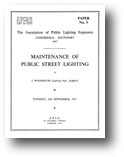
|
Maintenance Of Public Street Lighting
J. Woodhouse
(Lighting Department, Sheffield)
Keywords: Lighting: Equipment, Lighting: Maintenance, Lighting: Management
Tuesday, September 16th, 1947
A reproduction of the paper was published in: Public Lighting, Vol. 12, No. 46. October-December 1947. This
includes the discussion.
Abstract: Description of the roles within the lighting department, their responsibilites an
the maintenance schedules of both gas and electric street lighting. The paper also outlines
photometric testing which directs the frequency of cleaning.
"In our view, satisfactory maintenance is of no less importance than correct design" - MOT Final Report.
This statement was so framed as the committee had seen many installations and designs of installation where
it was obvious that maintenance had not been considered or left to take a secondary place. No installation
should be designed and installed unless relation to maintenance had been considered first. In Sheffield
we consider that an installation is 'new' for only two weeks; after that it must be watched and cared for as
any other installation in the city, remembering that this installation will have to stand for many years and
that its efficiency must never fall below a certain level.
The main contributory causes which affect the deterioration of a street lighting installation are:
- (1) Ageing of lamps or conditions of mantles and burners.
- (2) Fall in voltage or gas pressure
- (3) (a) Soiling of glassware and reflectors; (b) Dirt in burners and fittings.
Although, theoretically, luminous output of a gas mantle is not affected to any extent by burning hours,
in practice a reduction is found which may not be due to disintegration or slight breaks not obvious without
very close inspection.
The effect of light output of an electric lamp caused by a small drop in voltage is very serious.
A 5% drop in volts means a 17% fall in light output from a metal filament gas-filled lamp.
Only frequent cleaning can prevent dirt from having a serious effect upon an installtion.
Inspection
It is the practice in Sheffield for each lamp attendant to inspect the round allotted to him every night.
A round is that proportion of the city's lamps which can be inspected on foot or cycle in approximately
two hour and cleaned once per fortnight. High-mounted units i.e. lamps mounted 25ft. are included in a lamp
attendant's round for nightly inspection and report only. Lamps not lighted are reported immediately to the
Department. No round is allowed to go one night without inspection.
The Lamp Attendant's Daily Work Line is submitted by each lamp attendant to the Department
daily. It is a record of the number and addresses of all lamps cleaned that day, and the time
spent inspecting his round after lighting time. It also gives the number of controllers changed,
burned out electric lamps, broken nozzles and mantles, and defective fuses replaced.
The Chief Inspector, who is responsible to the Lighting Engineer for the work of
the lamp attendants, has inspectors or surveyors to supervise the work of each lamp attendant. The
Inspector checks upon the cleaning of the lamps and the general appearance of the lamps
when lighted. Without warning to the lamp attendant, the inspector may follow him out, ensure
he is engaged in cleaning, cehck his previous day's claim of lamps cleaned and examine the remainder
of his round. At lighting-time, the inspector will make an appointment with a lamp attendant
and together they will inspect the lamp attendant's round. The inspector reports to the
Lighting Engineer the following morning.
There is no fixed Inspector for a given sector or area of rounds. Each round is checked, in turn,
by all the Inspectors. The practice of fixed inspectors for a given sector has certain advantages:
It creates a competitive spririt among inspectors which an be inculcated into the lamp attendants;
it keeps the Inspector up to standard, as he is in competition with his fellow inspectors,
and is directly responsible for his own area. To offset the advantages is the fact that
we are human and personalities creep into our way of thinking. A lamp attendant who considers that
his inspector has a "down" on him so that, no matter what he does, it will never be right in
the case of fixed inspectors. Appeal can be made to the Chief Inspector but it is difficult
for him not to support his inspector. But following the Sheffield system these difficulties can
be avoided.
Mantles Used Per Nozzle
It is the practice in Sheffield to keep a record of the number of mantles used per nozzle by each lamp attendant. Month by month
the lamp attendant is informed of :
1. Number of mantles used during that period.
2. The number used during the corresponding period of the previous year.
3. The average number of mantles used per nozzle of the lamps under his care.
4. The average number of mantles used per nozzle over the whole city.
This system reveals the man who is lazy and negligent who changes mantles instead of cleaning burners, the man who is rough in
the handling of mantles, the man who is careless and clumsy while cleaning his lanterns.
Overhaul Of Controllers
The large number of gas controllers in use warrants a more or less continuous overhaul by the manufacturers, of a certain number each
month, so that at least once in five years every controller in use is overhauled. The resultant efficiency of operations each year
has never been less than 99.7%.
Cleaning Of Overhead Lamps
In Sheffield there are 45 miles of roadway lighted to the standard of the Traffic Route lighting
as recommended by the Ministry of Transport Departmental Committee. Due to Sheffield's industry
the main cause of decrease in efficiency is dirt. The lanterns are mainly directional fittings
with refractors not enclosed in a globe. Prismatic glassware is not easy to clean. The refractors
cannot be washed with cloths but with soap and water and taking tanks of water to the lanterns
was not quick enought. Therefore an additional stock of refractors were brought and this
floating stock are taken out to replace the dirty ones. The Food Office will allow a ration
of soap for this purpose. It is obvious that no recommendations can be made as to how
often a lamp shall be cleaned.
Refractor Absorption Test
By the means of tests, and plotting on graphs of the results of these tests, we
can accurately ascertain the degree of dirtiness the glassware of a fitting has after
a given number of days. When a route is cleaned, a random selection is made of each dirty
refractor to be cleaned and they are put into a specially designed fitting. No light escapes
from the fitting except through the refractor. The dirty fitting is placed in an
integrating photometer and the light output in lumens recorded. The refractor is washed, put
back in the fitting, and light output in lumens again recorded. Three refractors are
checked and the average percentage absorption of light is recorded. After making tests during
fifteen months, the results are summaries in graph form.
The dirt accumulates quicker in the winter months, when lamp replacements are higher than
in the summer months. The marked difference between industrial areas and suburb areas shows
that maintenenance conditions are not the same in all towns, and they are not the same
at all places in the same town. With the information from the graphs, it's possible to
plan the cleaning effectively.
Check On Maintenance
One of the first factors to determine is the time at which initial illumination tests shall be
made. Wheterh the checking of maintenance by illumination measurements is simple or not (from
the MOT Report 1937) they provide only a check. They do not tell us the fall in illumination.
|

|
The Design of Lamp Columns and the Royal Fine Art Commission
Mr. A. B. Knapp-Fisher, F.R.I.B.A., F.S.A., Hon. A.R.C.A
(Secretary of The Royal Fine Art Commission)
Keywords: Lighting: Design
Thursday, September 18th, 1947
A reproduction of the paper was published in: Public Lighting, Vol. 12, No. 47, Special Conference Issue, November 1947. This
includes the discussion.
Abstract: Explains the role and powers of the Fine Arts Commission, the concepts of 'good design',
how this can be obtained within the manufacturing environment, and the requirement to educate
authorities and the public on aesthetics.
The Commission have neither the powers nor the inclination to force ideas and ideals down your throats and they
strive to see that their theories are eminently practical and realistic. Your theorist, whether in Religion, Politics,
Art of Industry can be a menance.
The Commission, under His Majesty's Sign Manual, have wide powers and are charged to safe-guard
and improve what are called "the public amenities." The Commission seeks by co-operation
to adjust values, to denounce shams and to set a qualitative standard, but it needs the help
of an informed and educated public and the support of Industry.
The Royal Commission is a voluntary body entirely independent with no statutory powers. But
it has power to call for evidence and plans when its Commissioners think that public amenity is
in danger throug hteh action of any body public or private, lay or ecclesiastical and if
necessary to call to account or summon anyone from Cabinet ministers downward to give account
of what they are doing.
It is the Ministry of Transport's and the Commission's desire to raise the standard of
design of lamp columns and their efficiency in full co-operation with the Commission nd
with the Manufacturers until our street lighting can rank with the best in the world, both
from the practical and asethetic points of view.
It is the wish of the Commission to be able to approve those designs which they consider good
enought without of course the Commission's name being used to boost individual designs for
commerical purposes.
The words "design and industry" linked together have become a slogan today. There must be
complete understanding between the designer and the technician: that it has not been always so
is the fault of many contributory causes, not excluding the backwardness of many municipal
and other authorities.
What are the consideration to be borne in mind in designing lamp columns? All we can do
if place before manufacturers certain guiding principles which should govern the design and
appearance of these things. There are two main considerations: (1) Technical i.e. soundly practical and economical; and
(2) Aesthetic i.e. pleasing to the eye. The second must grow out of and express the first.
The old idea of an architect, artist or designer being called in to "embellish" or "adorn" an
otherwise practical object to be scotched. If there is a golden rule it is to exercise
restraint and indulge in economy or material and, generally speaking, to make the columns
as inconspicious as possible. There need be no conflict between aeshetic and practical
requirements. A healthy aesthetic comes through the intellect and the senses and is an
acquired thing, and its universal cultivation will be found necessary if industry is to flourish
and compete in the world's markets.
It is not easy to arrive at a good design. Some manufacturers are fortunate in having a good
designer on their staff or a potentially good designer who is ready to learn and here the
Royal Fine Art Commission and the Design and Industries Association and the Council for
Industrial Design can help. The Royal Fine Art Commission has men who have a through and
wide knowledge of the creative arts and who have made a life long study of design.
Standardisation should be avoided. It is essential that there should be a better understanding
in many towns and a closer co-operation between the lighting authorities and the Manufacturers
and their designers, and a greater readiness on teh part of the local authorities to
appreciate the general advance in design of street furniture. Local authorities should train
themselves in aesthetics. To avoid misunderstandings, "column" includes the lantern which is
part of the whole design and it's a pity that the column and lantern are designed separately.
The essentials are:
(1) Obtain the services of a first-rate designer.
(2) Ensure there is co-operation and thorough understanding between the arist craftsman,
the technician and the mangement, and that the status of your artist designer is second-to-none.
(3) Seek to educate the authorities concerned in particular and the public in general by
insisting on a high standard of design.
|
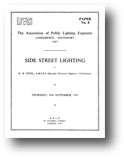
|
Side Street Lighting
R. W. Steel, A.M.I.E.E
(Borough Electrical Engineer, Cheltenham)
Keywords: Lighting: Anti-Social Behaviour, Lighting: Columns, Lighting: Control,
Lighting: Future, Lighting: History, Lighting: Luminaires, Lighting: Maintenance,
Lighting: Materials, Lighting: Specifications
Thursday, September 18th, 1947
A reproduction of the paper was published in: Public Lighting, Vol. 12, No. 48. October-December 1948. This
includes the discussion.
Abstract: Draws attention to many of the problems confronting the illuminating engineer in designing street lighting for side streets; and
gives examples showing how the problems were not fully recognised in the past, and how modern practice follows the MOT Report 1937. A suggestion
is made that there should be more than two groups to permit greater mounting heights and higher values of illumination of some Group B roads.
Attention is drawn to the problem of light obscuration by trees. And future trends are predicted.
INTRODUCTION
Most papers published in the last decade have dealt with Group A roads. This is natural as traffic routes in large
urban areas are sufficiently important to justify the modernisation of their lighting installations, and to warrant money
being spent to secure a high standard of lighting, so that both traffic and pedestrians may use them with a resonably low risk of
accident. However, most of the roads with public lighting are "side streets" so the Council of the Association felt that
attention should be drawn to some of the problems involved.
WHAT IS A SIDE STREET?
This is not defined by BS 307 (1931) or the MOT Report (1937). The B.S. Specification does not attempt to divide the highways into different
categories but is content to grade street lighting installations into eight different classes. The Interim Report (1935) only defines
"traffic routes". The Final Report (1937) classed Group A as "traffic routes" and all others roads as Group B. The roads classified under
Group B vary very widely and range from rows of terrace houses separated only by carriageways and a few feet of footway, to fairly wide streets
with wide footpaths and detached or semi-detached houses set well back. There is also the combined footways and carriageways of relatively
narrow dimensions which form the access roads togroups of houses situated in short cul-de-sacs found on housing estates. In all cases the
road traffic is relatively light and pedestrian traffic could not be described as "appreciable."
SUGGESTED NEW GROUP
The author feels that the grouping of all such roads within one category for the purpose of specifying standards of lighting is very wide
and there is room for at least a third group where the mounting height might be 18-20 ft. with the lumen output of 3,000-5,000 per 100 ft.
linear of road. Perhaps the main reason for selecting a mounting height of 25 feet for Group A roads was due to the desire to avoid glare
[partly - also to clearly differentiate between Groups]. With the coming into general use of the diffused light source and a general
use of cut-off fittings there may be good grounds for adopting 20 ft. mounting height where the road is not strictly a "through road"
or "traffic route with appreciable pedestrian traffic." It might be better by doing away with the sharp division to encourage motorists
to ignore mounting height and only use headlights when the variation in lighting makes it absolutely necessary to do so.
The report of the Departmental Committee, set up by the Minister of War Transport to consider the design and lay-out of roads in
built-up areas divided roads into five classes:
- Arterial Roads (Group A)
- Through Roads (Group A)
- Local Through Roads
- Local Roads (Group B)
- Development Roads (Group B)
The "Local Through Roads" might well fall into a new group where the mounting height would be 18-20 ft. and the standard of illumination
would be very little below Group A. Many of these "Local Through Roads", if they are suitably situated, are apt to be used as by-pass roads [rat-runs] where there
is congestion or if there are traffic signals that cause delay.
The lighting recommended for Group B roads in the Departmental Committee's final report is such that motorists when traversing
them after dark might be expected to use headlights and the mounting height would not normally exceed 15 ft. For the purpose of this
paper "side streets" covers non-traffic routes i.e. "local roads" and "development roads". The special problems of "Local Through Roads"
has been left to be discussed on another occassion.
EARLY STREET LIGHTING PRACTICE
In the past street lighting has been appraised by the degree of intensity of the sources of illumination rather than by
the effects it achieved. Early installations show that minimising the cost is the prime consideration and little or no
attention is paid to proper siting or spacing. There is no attempt as staggering as this would've involved the expense
of road crossings for the street lighting mains. The siting is bad: some are placed on street corners, where they
are liable to be knocked down or damaged by traffic; positioning at junctions is wrong; and the standards have been
erected on the inside of bends instead of the outside. Spacing has been extended in some cases to as much as 260 ft.,
resulting in pools of light separated by long areas of of semi-gloom. The lanterns are open type conical, non-directional,
fitted with 60W metal filament lamps, so the mounting height is 10 ft. 6 ins.
Additional columns can be installed to correct the worst of the faults.
EXAMPLES OF MODERN INSTALLATIONS
The columns are staggered along straight sections of road giving more even illumination over the whole width of the carriageway.
The placing of lanterns at street corners has been avoided and at tee junctions they have been placed opposite the joining road.
Where there are bends, the lamps have been sited on the outside footway and intersections have been treated in the
peroper manner. Footways have also been adequately lit. The spacing does not exceed 140 ft. and the mounting height is
15 ft. The lantern is a directional refractor type equipped with 45-watt horizontal sodium lamp. The combination of an improved
type of fitting, and a more highly efficient source of illumination, a standard of lighting many times better than it was before
has been achieved, with an increase in consumption of less than twice that of the earlier installation.
MODERN TYPES OF ELECTRIC LANTERNS
Progress over the last twenty years or so is exemplified by the introduction of mercury and sodium vapour
discharge lamps which have revolutionised electric street lighting practice. The lanterns designed for
tungsten filament lamps have been improved by the development of refractor glasses with the facets of the
prisms sealed between two pieces of glass, so preventing them from becoming dirty, and making cleaning
easier. Further improvements in effeciency by the introduction of the gas-filled and later the coiled-coil lamp
have been effected.
Mercury or sodium will soon superseed tungsten for new installations. At the moment, there seems to be
a rapid advance towards perfecting fluorescent lamps and fittings for street lighting, but they haven't
entered the side street lighting field yet.
The shape of the lanterns for use with discharge lamps varies greatly from the more familiar traditional
circular or square types. All lantern design has been "cleaned up" by making the outline simple and as
smooth as possible, to render cleaning and maintenance easier. A great deal of research has been carried
out into the ability of materials to stand up to operating conditions particularly with atmospheric
corrosion and vibration.
MODERN TYPES OF GAS LANTERNS
These differ greatly from those which were marketed twenty-five years ago, the chief visible improvements
being the introduction of refractor glasses and faceted reflectors. During the last twenty years
efficiency has considerably improved due to: (1) Improvement in the burner or source efficiency;
(2) Improvement in the stability of the burner; (3) More effective utilitsation of the light from the source.
It is the study of (3) which has produced the most fruitful results. In the best designs these improvements
show an increase in efficiency, in total lantern lumen output, of 40% to 50% ove the results achieved with
lanterns in use twenty years ago, with light distribution by reflectors or refractors.
Modern gas lanterns of larger output suitable for traffic route lighting direct more than 90% of their
total output in the lower hemisphere.
General attention has also been paid to the design of the bodies of the lanterns with a view to reducing
the obstruction they offer to the emission of light, so affording greater accessibility for maintenance,
and in the selection of materials to obtain greater durability. Several of the lanterns incorporate control
gear consisting of automatic constant pressure governors and clock control switching devices, and care is
given to house this auxiliary equipment in such a way as to give clean and pleasing outlines to the lamp
for good day-time appearance.
TREES
In some garden cities and towns, great difficulty is experienced in providing satisfactory and economic lighting
installations on account of the existing trees. In many cases, trees have been planted in narrow footways
which almost completely screen the lighting provided by what would otherwise be a well laid out system. The
lighting authority may have to adopt a central suspension system which is more clostly than a staggered
arrangement and in which the mounting height has to be increased to obtain the necessary clearance. Troubles
are increased in wet weather when the weight of the rain bears down the branches. The author suggests that the
subject is of sufficient importance to be considered jointly by the Ministry of Transport, the Association of
Municipal and County Engineers, the Institute of Park Administration and the Association of Public Lighting
Engineers, where the problem could be solved.
CAPITAL COSTS
The money has to be raised by a levy on the ratepayers through the general rate fund. Cost must therefore be
kept to a minimum consistent with obtaining reasonably good illumination. Public lighting engineers should be
very mindful of the economic problem, not only in initial expenditure but in running cost and maintenance. Capital
cost, which includes the cost of mains and service conditions, lamp standards, lighting fittings and control gear,
is especially heavy under present conditions. The range from which equipment is available has been narrowed down
considerably by the restrictions which are in force, and free choice is no longer available.
In 1939, the cost of a 15 ft. steel column was approximately £6 and today it is double that value; but a reinforced
concrete column costs between £8 and £12. The cost of lanterns varies widely and is affected by the type of
illuminant, as well as the shape and characteristics of the source of illumination, being higher for discharge lamps than
metal filament lamps. The optical system also affects the cost. The present day cost of an electric lamp column complete
with lamp and control gear, varies between £16 and £20; a modern gas lighting unit, complete with all controls
and column, costs £20.
On whom should the cost of street lighting fall when new estates are being developed? Costs therefore ought to be included
in road development charges. In the case of estates developed by local authorities, the initial capital cost would shift
from the rates to the rents, but in the case of privately built houses it would relieve the local authority of the cost.
The idea of considering street lighting capital costs as a road development charge may be worth pursuing as it would ensure a
good standard of street lighting from the outset. The extra cost which would fall on housing or road development would be
10% of the road charges.
MAINTENANCE COSTS
Maintenance cost must receive due attention, for the lantern which requires more frequent cleaning is more difficult to clean,
either increases the running cost or reduces the efficiency, whilst the cost of the illuminant, as well as repainting the columns themselves
must be taken into consideration.
Maintenance of electric lanterns has been made much easier by the extreme simplicity of design of the body of the lantern itself, and
in some cases by omitting the glass globes, leaving the refractor exposed, to be self cleaning, or very easily cleaned. The adoption of
remote control for switching or the use of electrically would time switches, together wit there's no process of combustion with
electric lamps, permits the maintenance visits to be relatively few and far between. Improvements in the life of the lamps themselves
have enabled maintenance costs to be brought down still further.
Very subtaintial advances have been made in the reduction of maintenance costs of gas lamps by careful attention to design. Maintenance
has been made easier by the adoption of lamps using small globes of standard size, with no sharp corners to cut the cleaners' hands. When panes
of glass have been used, the construction generally allows plenty of room for internal cleaning, the glass being of standard size and fully
interchangeable, thus reducing the need to carry large stocks. Easy access is provided to the clock controller, governor and fittings, which
are placed as near as possible to the burner to prevent unnecessary ladder work. When burners are removed for cleaning they can be replaced without
interfering with burner regulation. All these improvements have resulted in labour charges for maintenance being brought down by 60%, maintaining
a standard which does not permit the light output to fall below 75% of its initial value, well within the requirements of BS 307 (which allows
a fall of 50%).
Cast iron and steel columns both require painting, the steel columns demanding the treatment more often. Concrete
columns do not need painting. [There is a reference to corrosion of the reinforcements - but more data would be need to be
collected in time. Vibration or spinning reduces this risk to a minimum.] Cast iron is brittle and easily damaged. The resulting
cost of repair and replacement is higher than would be the case if steel or concrete columns were used in their place.
Vandalism is also a cost and is undoubtedly due to the relaxation of parental control of children during the war. This could be
minimised by cop-operating with the education authorities and if the cuprit is known, a visit to the head master of the
appropriate school has benefits.
MATERIALS
The metal work in the fittings, which having to withstand varying degrees of heat, must be carefully chosen. In recent years,
aluminium has been introduced for reflectors and initial troubles have been encountered. The extensive experience gained with this
material during the war enabled finishing techniques to be improved so it may be used with greater confidence. The wider adoption of
sources of illumination running at lower temperatures, evidenced by the adoption of fluorescent tubes, may greatly lessen the severity
of the conditions under which they operate. Plastic materials are making their appearance in place of glass but this is mainly because
of the reduced weight - as well as the ease of working plastic sheets into the special shapes required for large lanterns. For side
street lighting, platics are not yet a serious competitor with glass.
In the early days, cast iron was largely used for street lighting columns, but due to its brittleness and consequent danger to
life and property, it was rapidly being superseded by steel before the war.
Steel columns are now very difficult to obtain and the public lighting engineer has to purchase reinforced concrete columns.
Until recently they were only available in the normal cement finish and objection was raised to their use in urban areas on aesthetic
grounds. Today these columns are available with aggregates which tone down the whiteness of the normal cement column, and a polished
surface is now being widely adopted. The weight of these columns for 15 ft. mounting height does not present the same difficulty
as that of concrete columns for Group A roads.
CONTROL
It does not seem many years since the lamplighter went on his rounds, but now it is the practice to use remote control equipment
or time switches. In the case of electric lighting, this control is increasingly carried out by ripple control
systems. Many lamps are controlled either singly or in groups over an additional "fifth" core by time switches.
Control equipment using photo cells, which automatically switch on the lantern, have been used in a number of installations,
but has not been widely adopted. Much progress has also been made in the automatic control of gas lighting.
Clock controllers with self-setting dials are being brought into greater use with automatic adjustment of
lighting and extinguishing times. Catalytic ignition devices, operated by dry batteries, are being widely introduced.
THE FUTURE
The present tendency is for gas lantern deisgn to become smaller to facilitate cleaning and maintenance while burner
design is being concentrated on the aeromatic type which gives greatly improved combustion, resulting in higher
flame temperatures and consequent increase in light output. In the realm of electric lighting, the introduction of
the fluorescent tube has opened up an entirely new field, and although a few years ago it was confidently said that
such lamps could not be ussed out of doros for street lighting, many experimental installations have been operating
satisfactorily, even though cold periods. Present installations are restricted to traffic routes because of the length
of the lamp and the cost of the fitting - but there's no reason why there shouldn't be simple lightweight fittigns
for side streets in the near future particularly when 4 ft. and 3 ft. tube become generally available. The minimum height
would have to be 16 ft. 6 in. so that no damage would be caused to the installation by normal traffic.
Luminaires: GEC Z 9420 Sodium Lantern,
GEC Z 5221 Facet Directional Lantern,
GEC Z 5045 Open Wembley Lantern,
GEC Z 5540 Closed Wembley Lantern,
REVO C 12422,
REVO C 10738/9,
BTH Rural Open,
BTH Series 600,
ELECO Golden Ray,
Holophane Duo-Dome,
MV Ryde,
William Edgar & Son Eclipse,
Parkinson Maxilla,
Sugg Square Lamp,
Sugg Rochester,
Sugg London,
Sugg 8000 and
Willey Cranford.
References:
[1] Design and Layout of Roads in Built-up Areas, H.M. Stationery Office.
[2] Lantern design, J. G. Christopher and J. S. Smythe, B.Sc.(Eng), A.M.I.E.E., APLE Conference 1945
[3] Public Lighting - Administration, E. C. Lennox, M.I.E.E., F.I.E.S, APLE Conference 1946
[4] Remote Switching by Superimposed Currents, J. L. Carr, M.Sc., M.I.E.E., Journal I.E.E., Pt. 2, December 1946
|
|
|



